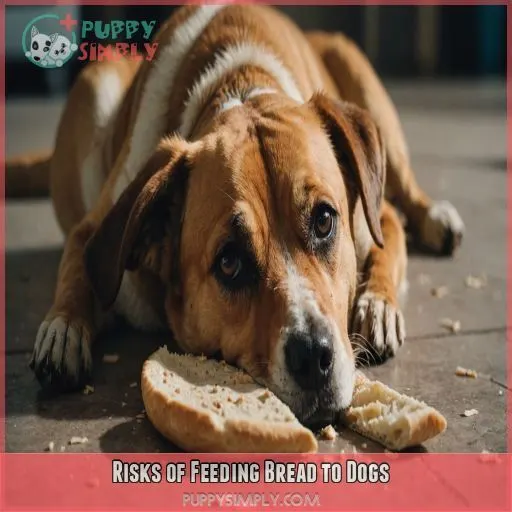This site is supported by our readers. We may earn a commission, at no cost to you, if you purchase through links.
 Yes, dogs can munch on pita bread as long as it doesn’t have toxic ingredients like garlic, onions, or xylitol.
Yes, dogs can munch on pita bread as long as it doesn’t have toxic ingredients like garlic, onions, or xylitol.
Think of pita bread as the plain white T-shirt of the bread world—harmless in small amounts but not the life of your pup’s party.
Too much can pad their paws with extra weight due to its carbs.
If your dog tends to be a gluten-free diva or has a monumental tummy upset after a nibble, call the vet.
Keep pita bread baked and never raw, as dough could bloat faster than you can say "doggy dough disaster!"
Curious about other breads? Let’s peek!
Table Of Contents
- Key Takeaways
- Can Dogs Eat Pita Bread?
- Types of Bread Safe for Dogs
- Risks of Feeding Bread to Dogs
- Bread and Canine Health Issues
- What to Do if Your Dog Eats Bread
- Alternatives to Bread for Dogs
- Frequently Asked Questions (FAQs)
- Can you give a dog pita bread?
- What kind of bread is safe for dogs?
- Why can’t dogs eat bread?
- Can dogs eat Stacy’s pita chips?
- Can pita bread upset a dogs stomach?
- Do dogs prefer pita bread over other breads?
- Can diabetic dogs eat pita bread?
- Is it safe to microwave pita bread for dogs?
- How often can dogs eat pita bread?
- Conclusion
Key Takeaways
- When contemplating sharing that pita with your pup, keep it plain and simple. Ensure it’s free from harmful ingredients like garlic or onions, or you might find yourself in a "doggy dough disaster!" Moderation is your best friend – think of it as a tiny treat, not a meal.
- You’ve got to be mindful of portion sizes. Too much pita can lead to your furry friend packing on extra pounds, turning into a fluffy loaf rather than the playful pup you adore. Balancing treats with a healthy diet is key to keeping tails wagging and bellies happy.
- Watch out for signs of discomfort after pita crumbs disappear. If your dog shows unusual behaviors or tummy troubles, it’s time to consult the vet. Their health is as precious as that last slice of cake you’re hiding from them!
- While pita bread isn’t harmful in small doses, it’s not exactly packed with nutrition for your canine buddy. For more nutritious snack ideas, think crunchy carrots or juicy apple slices – they’re dog-safe and bound to get tails wagging in delight.
Can Dogs Eat Pita Bread?
Wondering if your dog can join you for a pita snack? Don’t worry, a plain piece is safe, but make sure it’s free of any hidden doggy dangers!
What is Pita Bread Made Of?
Pita bread, originating from the Middle East, is a popular choice worldwide. It’s typically made with simple ingredients: wheat flour, yeast, and water. Think of it as the friendly neighbor of breads, with its soft pocket perfect for filling. While it mightn’t be a revolutionary treat for your pooch, understanding its makeup is key to thinking about dog food alternatives.
Is Pita Bread Safe for Dogs?
Pita bread is generally safe for dogs to eat in moderation, as long as it doesn’t contain any toxic ingredients like garlic, onions, or xylitol. Just be mindful of portion sizes, as the carbs in pita could contribute to weight gain if fed excessively. Consult your vet if your pup has any wheat or grain allergies.
What Happens if a Dog Eats Pita Bread?
Understanding if pita bread is safe for dogs leaves the question: what happens if your furry buddy sneaks a taste? Generally, a little won’t harm them, but moderation’s key. Watch for signs of discomfort like bloating or tummy upset.
- Keep an eye on unusual dog behavior.
- Consider potential dog allergies.
- Consult vet advice if symptoms arise.
- Avoid making it a regular treat.
Types of Bread Safe for Dogs
You wouldn’t want your furry friend to turn into a literal loaf, so it’s important to know what types of bread are safe to share. While plain wheat, sourdough, white, rye, and pita bread without toxic ingredients can be okay in small amounts, always make sure your dog isn’t allergic and isn’t munching on the whole baguette.
Plain Wheat Bread
Pita bread isn’t alone in the safe category—plain wheat bread can also be okay for dogs, in moderation. While not a dog’s dream meal, keeping it simple like this can be just the ticket for an occasional treat without the doggie drama.
| Issue | Safe for Dogs? | Watch Out For |
|---|---|---|
| Plain Wheat Bread | Yes | Overfeeding |
| Pita Bread | Yes | Ingredients |
| Homemade Wheat Bread | Yes | Allergies |
Sourdough Bread
Sourdough bread is generally safe for dogs without wheat or grain allergies. The fermentation process breaks down gluten, making it easier to digest. Homemade sourdough is best, as store-bought varieties may contain additional ingredients. Introduce sourdough slowly and monitor your pup for any signs of digestive upset. As with any new food, consult your vet first.
White Bread
Regarding white bread, don’t fret too much about sharing a tiny morsel with your dogit’s not the end of the world. Although white bread provides little nutritional value, in small amounts it’s unlikely to cause harm. Just remember, moderation is key! Focus on healthier dog treats, and always prioritize your dog’s health above all.
Rye Bread
Rye bread has a rich history, but is it safe for dogs?
Generally, it’s okay if your pup isn’t allergic.
Rye bread’s nutritional value is similar to wheat bread, but moderation is key to avoid dog digestion hiccups.
A nibble is fine, but don’t make it a staple dog food.
Keep your furry friend’s health in mind – safety first, snack second!
Pita Bread Without Toxic Ingredients
Pita bread, my friends, isn’t bad for dogs in moderation! Make sure it’s free of any toxic ingredients like garlic or onion. Think of it as a blank canvas for your dog’s snack time. Much like a homemade pita recipe, it’s plain and simple. Compared to tortillas, it’s fluffier but still safe. Just remember, moderation is key for dog health!
Risks of Feeding Bread to Dogs
While a little bread won’t hurt your pup, you’ll want to steer clear of yeast-based doughs, garlic, onions, xylitol, chocolate, raisins, and nuts – these can be downright dangerous for dogs. Too much bread can also lead to weight gain and other health issues, so it’s best enjoyed in moderation.
Yeast-Based Bread Dough Toxicosis
You’ve uncovered safe bread types for dogs, but yeast-based dough is another beast entirely! When yeast ferments in your pup’s tummy, it can balloon like a bouncy castle. Watch for these signs:
- Bloating: It’s not just puppy fat.
- Ethanol Poisoning: Think high-risk happy hour.
- Seek Emergency Vet Care: Fast as lightning!
Yeast-based bread dangers are no loafing matter!
Garlic and Onion Toxicity
Imagine this: your pup’s nose leads them to a luscious loaf containing garlic or onions. Before you know it, they’re gobbling it up like it’s the world’s biggest kibble! Unfortunately, garlic and onion can be toxic to dogs, affecting their red blood cells. Keep an eye on them, make sure they’re safe, and avoid these toxic foods like the plague!
Xylitol and Chocolate Toxicity
While skipping garlic and onions, don’t forget about the sweet stuff threatening your pup’s safety. Xylitol poisoning from sugar-free treats and chocolate toxicity symptoms can be nasty surprises. With safe dog treats, you’re the hero in your dog’s life story. Can dogs eat these sweet dangers? Nope! Stick to chocolate alternatives for peace of mind and happy tails.
Raisin and Nut Toxicity
Raisins and nuts can be downright dangerous for your pup. These tasty human treats contain compounds that can cause kidney failure and other nasty side effects in dogs. Keep your furry friend safe by steering clear of anything containing raisins, grapes, macadamia nuts, or other nuts. Their health is too precious to risk.
Excessive Carbohydrates and Obesity
After tackling those pesky nuts and raisins, watch out for excessive carbohydrates! Too much pita bread can turn your pup into a couch potato. Balance is key for dog weight management to prevent dog obesity. Consider:
- Healthy dog treats
- Carbohydrate alternatives
- Dog health supplements
- Regular dog exercise
- A balanced dog diet
Keep their tails wagging, not dragging!
Bread and Canine Health Issues
Even though bread can be a comfort food for humans, it doesn’t always sit well with your furry friend. From triggering upset stomachs to causing allergic reactions, bread mightn’t be the best treat for your dog, so let’s break it down before you break off a piece for your pup.
Can Dogs Eat Bread With Upset Stomachs?
When your dog has an upset stomach, bread might seem comforting, but it’s not the best remedy. Like a bland teddy bear, it’s there, yet doesn’t solve the problem. Instead, stick to vet-approved dog food or safe treats. If Fido’s tummy troubles persist, it’s time to consult vet advice. Better safe than sorry!
Bread and Allergies in Dogs
If your pup has a wheat or grain allergy, you’ll want to steer clear of feeding them pita bread or other wheat-based breads. Look for signs like itchy skin, ear infections, or digestive upset after eating bread. Instead, opt for dog-safe alternatives like sweet potatoes, green beans, or specially formulated hypoallergenic dog food.
Bread and Digestive Issues in Dogs
While bread isn’t the worst villain in a dog’s diet saga, it can be a sneaky culprit behind digestive issues. Dogs munching on bread might face stomach upset or gas, especially newbies to wheat. Remember, Fido’s tummy isn’t a breadbasket! If your dog’s feeling off, consider tweaking their diet and reach out to your vet for guidance.
What to Do if Your Dog Eats Bread
If your dog gobbles up some bread, don’t panic—just keep an eye out for any signs of tummy troubles. Remember, not all breads are created equal, so it’s important to reach out to your vet for advice, especially if yeast dough or toxic ingredients are involved.
Emergency Care for Yeast-Based Dough Consumption
If your dog gets curious and munches on yeast dough, it’s emergency time! Yeast expands and ferments in their stomach, potentially causing bloat or even canine alcohol poisoning. Grab your phone, call emergency vets immediately, and explain the situation. Think of it as your dog’s sudden, unwanted invite to a sourdough party—quick action is the key!
Monitoring for Signs of Stomach Upset
If your pup scarfs down some bread, keep an eye out for signs of stomach upset like vomiting, diarrhea, lethargy, gas, or abdominal pain. These could indicate digestive distress. Don’t panic – just monitor your canine closely and adjust their diet as needed. With a little TLC, they’ll likely bounce back in no time.
Contacting a Veterinarian for Advice
If Fluffy’s eaten something questionable, it’s wise to get the scoop from a vet. Vet advice can nip potential dog health issues in the bud. Follow these steps for peace of mind:
- Contact a veterinarian: Its never too early for expert dog health insights.
- Describe the incident: Provide details about the dogs snack drama.
- Listen carefully: Veterinary input on pet care is golden.
- Act quickly: If recommended.
Your dog deserves the best dog food and pet care!
Alternatives to Bread for Dogs
While pita bread’s okay for dogs in small amounts, let’s explore some healthier treat alternatives that’ll have their tails wagging with joy. Your pup can enjoy everything from crunchy carrots to sweet apple slices for a snack that’s both tasty and safe.
Healthy Treat Options for Dogs
If your dog’s gobbled some bread and you’re on high alert, offering healthy treat options can shift focus. Consider dog-safe snacks like carrot sticks or homemade dog treats that keep tails wagging. Toss them healthy chew toys for a safe and happy chomping alternative. Remember, a wagging tail means happy dog health, so choose natural dog treats over store brands.
Nutritious Snacks for Dogs
Instead of feeding your pup pita bread, consider these nutritious snack options that cater to their unique dietary needs. From fresh fruits and veggies to homemade treats, there are plenty of delicious and healthy alternatives that will have your canine companion’s tail wagging in delight:
- Carrot sticks
- Frozen banana bites
- Peanut butter-stuffed Kongs
- Air-popped popcorn (without salt or butter)
Canine-Friendly Foods and Ingredients
You might think pita bread is a great treat for your dog, but hold your horses!
Dogs love safe snacks like carrots, apples (hold the seeds), and pumpkin.
Want homemade recipes? Try frozen yogurt or peanut butter goodies.
These canine-friendly foods guarantee safety without the allergy concerns often lurking in kibble ingredients.
Who knew eating smart could be such fun?
Frequently Asked Questions (FAQs)
Can you give a dog pita bread?
You can absolutely give your pup a bite of plain pita bread now and then. Just be sure to avoid any pitas with added ingredients like garlic, onions, or other foods that can upset a dog’s tummy.
What kind of bread is safe for dogs?
Sure, your pup can munch on small amounts of plain wheat, rye, sourdough, or white bread—think of it as a little treat, not a meal. Just watch out for any sneaky toxic ingredients hidden inside!
Why can’t dogs eat bread?
Too much of a good thing can spoil the broth." While plain bread’s safe in moderation, it offers little nutrition and can lead to obesity. Plus, some breads have harmful ingredients. Always check with your vet first!
Can dogs eat Stacy’s pita chips?
Feeding your dog Stacy’s pita chips isn’t the best idea. While they’re tasty to us, the high salt and seasoning can upset your pup’s tummy. Stick to plain, unseasoned treats for a wagging approval!
Can pita bread upset a dogs stomach?
Pita bread shouldn’t upset your pup’s tummy, as long as it’s plain and doesn’t contain any toxic ingredients. Just remember, it’s not the most nutritious snack, so go easy on the pita treats. Your vet can give you the scoop on safe people food for Fido.
Do dogs prefer pita bread over other breads?
While dogs might give you those puppy eyes for pita bread, there’s no clear preference over other types. What matters is moderation and ensuring it doesn’t contain any harmful ingredients. Keep treats safe!
Can diabetic dogs eat pita bread?
Diabetic dogs nibbling pita bread is a bit like sneaking dessert before dinner. It’s not toxic, but high carbs can spike blood sugar levels—best to skip it. Consult your vet for safe treats instead!
Is it safe to microwave pita bread for dogs?
Microwaving pita bread for your dog is a breeze, like a walk in the park! Just make sure it’s cooled down, safe, and plain—without the "extras" that dogs shouldn’t gobble. Always think of their sensitive tummies!
How often can dogs eat pita bread?
You can give your pup a small piece of plain pita bread as an occasional treat, but don’t overdo it. Stick to just a bite or two to avoid tummy troubles.
Conclusion
Imagine your pup’s belly as a fine-tuned orchestra.
The right food keeps it in harmony.
So, can dogs eat pita bread? Yes, but simplicity is key!
A little pita bread won’t cause an encore, but too much can lead to out-of-tune tummy troubles or extra fluff on Fido.
Stick to small, ingredient-safe servings, and always watch out for any cymbal crashes of upset.
When in doubt, consult your veterinarian for a tail-waggingly happy pet.











